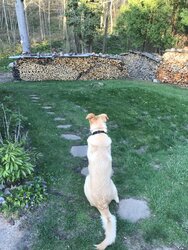I can see that this is a pretty frequent topic on this site. I apologize if it's already been answered, but I think that this question is slightly different. I have 6 cords of wood CSS right now. I will only burn 2 this winter. Those two cords will be moved into the garage/woodshed late fall this year. My question is this: Can I leave the other 4 cords uncovered this winter as they will stay drying where they are all of next spring/summer/fall?
I could certainly find some tarps to cover them with for the winter, but If I don't have to I'd rather not. Not sure if this makes a difference, but the wood that would be staying out for the winter is all large splits of red oak and hickory.
Thank you in advance
Doug
I could certainly find some tarps to cover them with for the winter, but If I don't have to I'd rather not. Not sure if this makes a difference, but the wood that would be staying out for the winter is all large splits of red oak and hickory.
Thank you in advance
Doug


 The area where I have it stacked gets full southern exposure and a decent amount of wind. I will definitely try covering right after stacking next year if this doesn't work out
The area where I have it stacked gets full southern exposure and a decent amount of wind. I will definitely try covering right after stacking next year if this doesn't work out